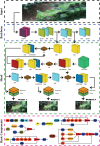Tea leaf disease detection and identification based on YOLOv7 (YOLO-T)
- PMID: 37055480
- PMCID: PMC10102080
- DOI: 10.1038/s41598-023-33270-4
Tea leaf disease detection and identification based on YOLOv7 (YOLO-T)
Abstract
A reliable and accurate diagnosis and identification system is required to prevent and manage tea leaf diseases. Tea leaf diseases are detected manually, increasing time and affecting yield quality and productivity. This study aims to present an artificial intelligence-based solution to the problem of tea leaf disease detection by training the fastest single-stage object detection model, YOLOv7, on the diseased tea leaf dataset collected from four prominent tea gardens in Bangladesh. 4000 digital images of five types of leaf diseases are collected from these tea gardens, generating a manually annotated, data-augmented leaf disease image dataset. This study incorporates data augmentation approaches to solve the issue of insufficient sample sizes. The detection and identification results for the YOLOv7 approach are validated by prominent statistical metrics like detection accuracy, precision, recall, mAP value, and F1-score, which resulted in 97.3%, 96.7%, 96.4%, 98.2%, and 0.965, respectively. Experimental results demonstrate that YOLOv7 for tea leaf diseases in natural scene images is superior to existing target detection and identification networks, including CNN, Deep CNN, DNN, AX-Retina Net, improved DCNN, YOLOv5, and Multi-objective image segmentation. Hence, this study is expected to minimize the workload of entomologists and aid in the rapid identification and detection of tea leaf diseases, thus minimizing economic losses.
© 2023. The Author(s).
Conflict of interest statement
The authors declare no competing interests.
Figures










Similar articles
-
Detection and identification of tea leaf diseases based on AX-RetinaNet.Sci Rep. 2022 Feb 9;12(1):2183. doi: 10.1038/s41598-022-06181-z. Sci Rep. 2022. PMID: 35140287 Free PMC article.
-
BRA-YOLOv7: improvements on large leaf disease object detection using FasterNet and dual-level routing attention in YOLOv7.Front Plant Sci. 2024 Dec 9;15:1373104. doi: 10.3389/fpls.2024.1373104. eCollection 2024. Front Plant Sci. 2024. PMID: 39717727 Free PMC article.
-
YOLOv7-DWS: tea bud recognition and detection network in multi-density environment via improved YOLOv7.Front Plant Sci. 2025 Jan 7;15:1503033. doi: 10.3389/fpls.2024.1503033. eCollection 2024. Front Plant Sci. 2025. PMID: 39840356 Free PMC article.
-
TBC-YOLOv7: a refined YOLOv7-based algorithm for tea bud grading detection.Front Plant Sci. 2023 Aug 17;14:1223410. doi: 10.3389/fpls.2023.1223410. eCollection 2023. Front Plant Sci. 2023. PMID: 37662161 Free PMC article.
-
Advancing common bean (Phaseolus vulgaris L.) disease detection with YOLO driven deep learning to enhance agricultural AI.Sci Rep. 2024 Jul 6;14(1):15596. doi: 10.1038/s41598-024-66281-w. Sci Rep. 2024. PMID: 38971939 Free PMC article.
Cited by
-
High-resolution dataset for tea garden disease management: Precision agriculture insights.Data Brief. 2025 Feb 12;59:111379. doi: 10.1016/j.dib.2025.111379. eCollection 2025 Apr. Data Brief. 2025. PMID: 40103762 Free PMC article.
-
A Candy Defect Detection Method Based on StyleGAN2 and Improved YOLOv7 for Imbalanced Data.Foods. 2024 Oct 21;13(20):3343. doi: 10.3390/foods13203343. Foods. 2024. PMID: 39456405 Free PMC article.
-
Non-destructive detection of single-seed viability in maize using hyperspectral imaging technology and multi-scale 3D convolutional neural network.Front Plant Sci. 2023 Aug 29;14:1248598. doi: 10.3389/fpls.2023.1248598. eCollection 2023. Front Plant Sci. 2023. PMID: 37711294 Free PMC article.
-
Advancing mango leaf variant identification with a robust multi-layer perceptron model.Sci Rep. 2024 Nov 9;14(1):27406. doi: 10.1038/s41598-024-74612-0. Sci Rep. 2024. PMID: 39521776 Free PMC article.
-
DraiNet: AI-driven decision support in pneumothorax and pleural effusion management.Pediatr Surg Int. 2023 Dec 27;40(1):30. doi: 10.1007/s00383-023-05609-5. Pediatr Surg Int. 2023. PMID: 38151565
References
-
- Sanlier N, Gokcen BB, Altuğ M. Tea consumption and disease correlations. Trends Food Sci. Technol. 2018;78:95–106. doi: 10.1016/j.tifs.2018.05.026. - DOI
-
- Verma HV. Coffee and tea: Socio-cultural meaning, context and branding. Asia-Pac. J. Manag. Res. Innov. 2013;9(2):157–170. doi: 10.1177/2319510X13504283. - DOI
-
- Debnath B, Haldar D, Purkait MK. Potential and sustainable utilization of tea waste: A review on present status and future trends. J. Environ. Chem. Eng. 2021;9(5):106179. doi: 10.1016/j.jece.2021.106179. - DOI
-
- Hu G, Yang X, Zhang Y, Wan M. Identification of tea leaf diseases by using an improved deep convolutional neural network. Sustain. Comput. Inf. Syst. 2019;24:100353. doi: 10.1016/j.suscom.2019.100353. - DOI
-
- Ahmed JU, Mozahid M, Dhar AR, Alamgir M, Jannat A, Islam M. Food security and dietary diversity of tea workers of two tea gardens in greater Sylhet district of Bangladesh. GeoJournal. 2021;86(2):1015–1027. doi: 10.1007/s10708-019-10108-z. - DOI
Publication types
MeSH terms
Substances
LinkOut - more resources
Full Text Sources

